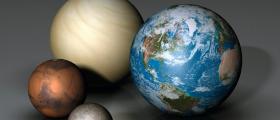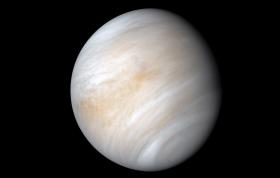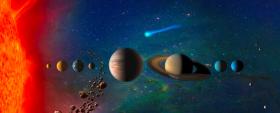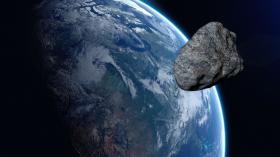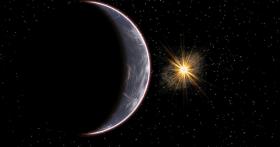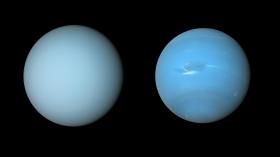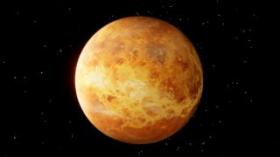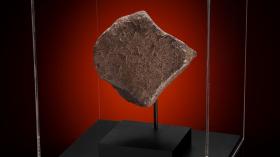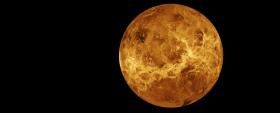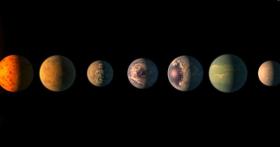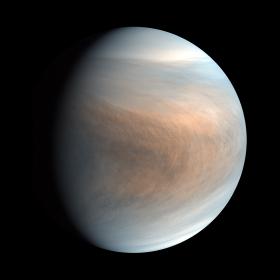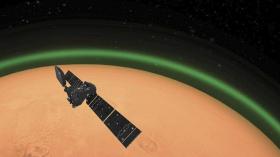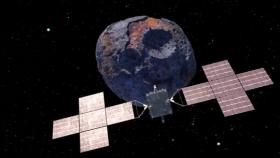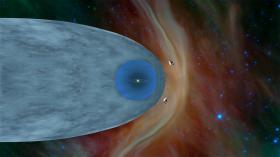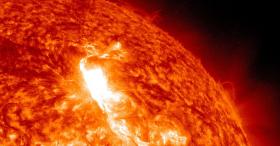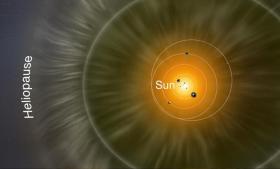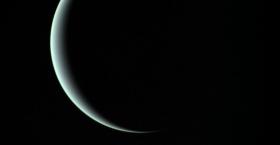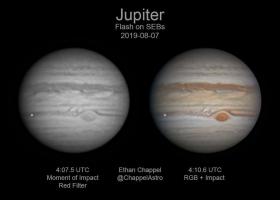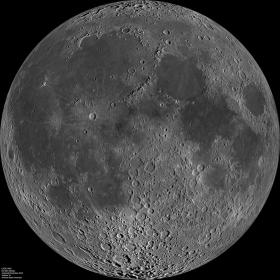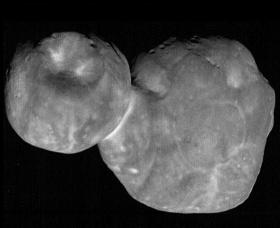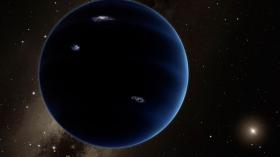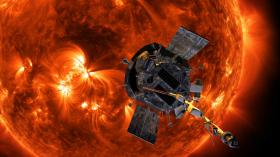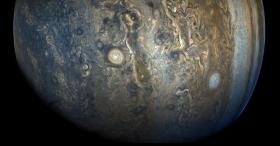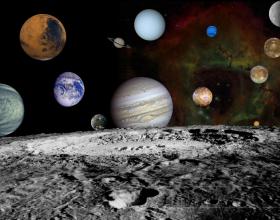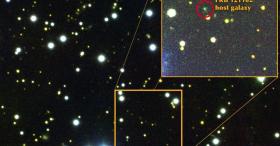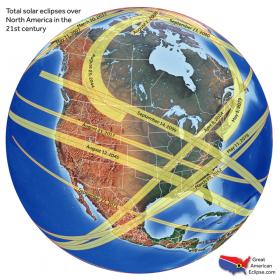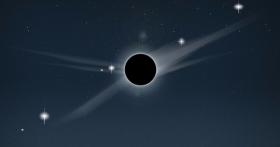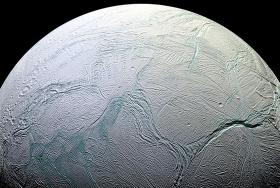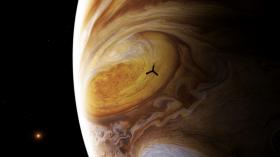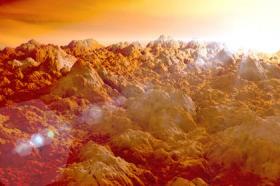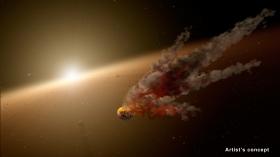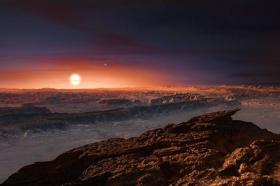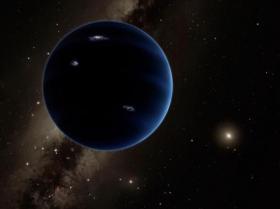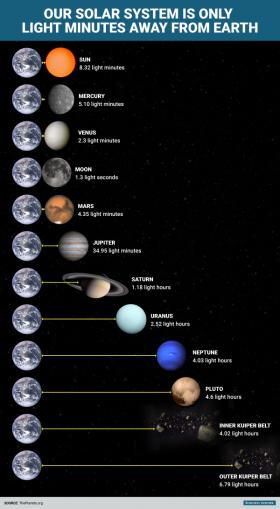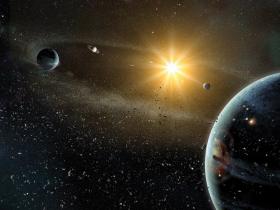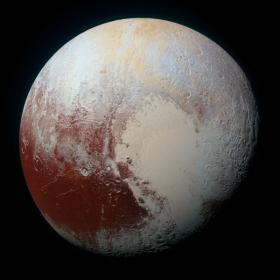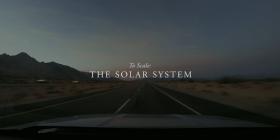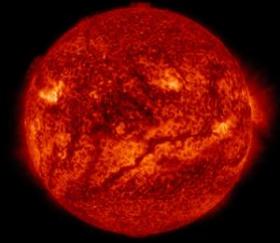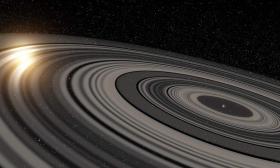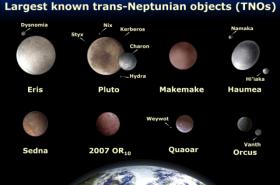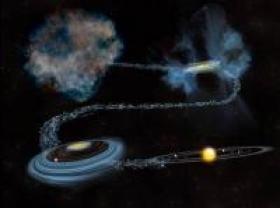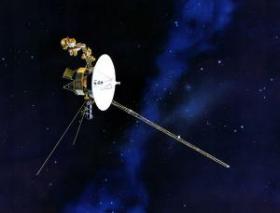#SolarSystem
Science & Technology | Science & Technology
It's Official: Scientists Confirm What's Inside The Moon
Well, the verdict is in.
Science & Technology | Science
The closest planet to Earth? Probably not the one you’re thinking of
There has recently been some confusion over which of the planets of the Solar System is closest to Earth.
Science & Technology | Science
'Hidden' planet at edge of our solar system could be five times the size of Earth
Scientists believe that a huge planet which has never been seen by astronomers could be lurking, almost invisibly, at the dark edges of our solar system.
Science & Technology | Science & Technology
NASA video explains why Venus is often called ‘Earth’s evil twin’
Astronomers often refer to Venus as Earth's evil twin, but what exactly does that mean and why did that nickname come to be?
Science & Technology | Science & Space
We've Never Found Anything Like The Solar System. Is It a Freak in Space?
Since the landmark discovery in 1992 of two planets orbiting a star outside of our Solar System, thousands of new worlds have been added to a rapidly growing list of 'exoplanets' in the Milky Way galaxy. We've learnt many things from this
Science & Technology | Science
Two skyscraper-size asteroids are barreling toward Earth this weekend
Two asteroids, 2016 CZ31 and 2013 CU83, are headed toward Earth for back-to-back flybys this weekend.
Science & Technology | Science
Planet Nine: The answer to this cosmic mystery may come sooner than you think
Is it a planet, a black hole, or a group of planets? One astronomer has an ambitious idea to find out.
Science & Technology | Science
We now know why Uranus and Neptune are different colours
Observations have revealed why Uranus and Neptune – the same in almost every way – are different colours.
Science & Technology | Science & Technology
What’s Happening To Neptune? Massive Telescopes See Something Weird Going On With The Eighth Planet
Surprised astronomers have watched a drop in Neptune’s global temperatures followed by a dramatic warming at its south pole. What's happening on the "ice giant" and should NASA send a spacecraft to investigate?
Science & Technology | Science
Planet Venus Facts: A Hot, Hellish & Volcanic Planet
Venus is the hottest and brightest planet in the solar system
Science & Technology | Science
Sun erupts with 17 flares from single sunspot, triggering solar storms
An overactive sunspot erupted with 17 different flares since Monday (March 28) and could amp up Earth's auroras.
Miscellaneous | Interesting Links
You Can Own a Piece of Mars—Provided You Have $800,000
A new Christie's auction features chunks of Mars, the Moon, and the only known meteorite to ever cause a fatality. (It was a cow.)
Science & Technology | Science & Space
Could NASA Really Find Life on Venus? Here's The Most Likely Place to Look
NASA has selected two missions, dubbed DAVINCI+ and VERITAS, to study the "lost habitable" world of Venus. Each mission will receive approximately US$500 million for development and both are expected to launch between 2028 and 2030.
Science & Technology | Science & Technology
These 7 Earth-size exoplanets named after beer may be incredibly similar
Just 40 light-years from Earth is the TRAPPIST-1 planetary system, which includes seven rocky Earth-size planets closely orbiting a dwarf star. Unlike in our solar system, these planets all have a similar density and may have the same composition.
Science & Technology | Science
Why Doesn't the Earth Have a Bunch of Mini Moons? | WIRED
To answer this question, let's take a look at something called the Three-Body Problem.
Science & Technology | Science
Scientists find possible sign of life on Venus
Astronomers have found phosphine in the atmosphere of Venus, possibly indicating life.
Science & Technology | Science
A green glow has appeared around Mars
The Mars Trace Gas Orbiter spotted a phenomenon on Mars that has also been observed around Earth. A green glow outlining the planet is the result of charged oxygen atoms gradually calming down.
Science & Technology | Science
$700 Quintillion Metal Asteroid Is Likely Former Planet Core
16 Psyche, an asteroid made up of 95% metals, is estimated to be worth $700 quintillion, and may even be the former core of a protoplanet.
Science & Technology | Science
Interstellar space even weirder than expected, NASA's Voyager 2 reveals
The spacecraft is just the second ever to venture beyond the boundary that separates us from the rest of the galaxy.
Science & Technology | Science & Space
Why is space so cold if the sun is so hot?
Earth is a pretty mild place, but space is full of wild temperature extremes.
Science & Technology | Science
Voyager Mission Detects Unexpected Pressure At The Edge Of The Solar System
NASA’s Voyager 1 mission scientists have calculated the total pressure from particles in the outer region of the solar system, known as the heliosheath during an opportune timing of a solar event that made the measurement possible.
Science & Technology | Science
NASA confirms mission to Jupiter’s moon Europa to explore its icy oceans | TechCrunch
NASA has confirmed a mission to Europa, one of the moons of Jupiter, will indeed happen. The mission was initially explored starting in 2017, with the space agency looking for reports on how it might proceed, and now NASA has said it will go ahead and mov
Science & Technology | Science
NASA's Voyagers Grow Weaker Each Year. What NASA Is Doing About It.
NASA is rationing watts to keep its oldest mission going.
Science & Technology | Science
Jupiter just got slammed by something so big we saw it from Earth
It's bright, it's white and fortunately it's very far away from here.
Science & Technology | Science
The moon may be tectonically active, and geologists are shaken
A new look at Apollo-era seismic data revealed that the moon's insides might be warmer than scientists thought possible.
Miscellaneous | Interesting Links
Weirdly shaped, very dark: Ultima Thule is revealing the outer solar system’s secrets
Scientists are learning more and more about Ultima Thule, the Kuiper Belt object visited two months ago by NASA’s New Horizons spacecraft.
Science & Technology | Science
The solar system's hidden Planet X may finally be spotted soon
A new paper suggests the hidden world known as Planet X is closer to being seen than previously thought.
Science & Technology | Science & Space
NASA’s Parker Solar Probe Just Smashed Two Records in a Single Day
NASA’s historic mission to “touch the Sun” just reached two important milestones: It now holds the record for the closest approach to the Sun by a human-built object—and also the record for the fastest spacecraft ever sent into space.
Science & Technology | Science
Astronomers have found a new crop of moons around Jupiter, and one of them is a weirdo - The Verge
Ten more moons have been confirmed to orbit around Jupiter, bringing the planet’s total known satellite count to 79. That’s the highest number of moons of any planet in the Solar System.
Science & Technology | Cool Stuff
Solar Systems Are Like Peas in a Pod—But Ours Is Wildly Disordered
Other systems are orderly and neat.
Science & Technology | Science
Scientists Detect Mysterious Radio Signals From Deep Space | HuffPost
Strange bursts are coming from 3 billion light years away.
Science & Technology | Science
The Next Solar Eclipse: Eclipse Maps for the Next 50 Years | Time.com
We've listed every total solar eclipse for the next 50 years, after the one on August 21, with maps showing each eclipse's projected path
Miscellaneous | Interesting Links
Here's how to see other planets during the total solar eclipse
If you look to the sky during the total solar eclipse on August 21, planets will appear. Here's how to see them.
Science & Technology | Cool Stuff
Scientists have a new plan for finding extraterrestrial life in our Solar System
Humanity hasn't even scratched the surface of exploring the Milky Way galaxy, much less the rest of the universe, but when it comes to our own Solar System, we have a pretty good idea of what's here.
Science & Technology | Science
Jupiter’s stunning Great Red Spot, seen like never before
NASA's Juno probe just swooped past the biggest storm in our solar system.
Science & Technology | Science & Space
Why Are the Mountains on Mars So Much Taller Than Those on Earth? | Mental Floss
Test your knowledge with amazing and interesting facts, trivia, quizzes, and brain teaser games on MentalFloss.com.
Science & Technology | Cosmic Research
Animation shows how many dwarf planets might orbit past Pluto
Pluto is just an icy appetizer for dwarf planets that may exist in the Kuiper Belt.
Science & Technology | Science
What Happened To The Object That Created Our Moon?
What happened to the object that slammed into the Earth to create the Moon? Was it destroyed entirely, or does it linger in one place?
Science & Technology | Cosmic Research
Earth-like Planet Discovered Near Solar System
European astronomers announced their discovery of a small rocky planet potentially hospitable to life circling the star closest to our own solar system—our nearest neighbor in a galaxy dense with unexplored alien worlds.
Science & Technology | Cool Stuff
Planet Nine? Evidence Grows for Big Addition to Solar System
As described by Brown and fellow astronomer Konstantin Batygin Wednesday in the Astronomical Journal, this new planet would be roughly 10 times the size of the Earth and would take as much as 20,000 years to make a single orbit around the sun. Its theore
Science & Technology | Cool Stuff
Here's how ridiculously fast we could visit everything in the solar system if we traveled at the speed of light
For humans, the mysteriously wondrous planets and moons in our solar system are ridiculously far...
Science & Technology | Cosmic Research
Leading Theory Of Solar System Formation Just Disproved! — Starts With A Bang! — Medium
Looks like the inner planets formed *after* the gas giants moved to their current position, and Jupiter ejected a fifth …
Science & Technology | Cool Stuff
Sharpest Pluto photos ever released are in stunning color and changing how we see this perplexing world
NASA has released the sharpest images yet of Pluto. What's more, unlike the usual black-and-white...
Science & Technology | Cosmic Research
To Scale: The Solar System on Vimeo
On a dry lakebed in Nevada, a group of friends build the first scale model of the solar system with complete planetary orbits: a true illustration of our place in…
Science & Technology | Cool Stuff
NASA probe beams back its first color image of Pluto - CNN.com
After more than nine years of traveling through the solar system, NASA's New Horizons spacecraft has sent back its first color image of Pluto.
Science & Technology | Cool Stuff
NASA releases stunning five-year time lapse of the sun
The Solar Dynamics Observatory, which launched five years ago, has been recording breathtaking images of the Sun.
Science & Technology | Science
Rings Like Saturn’s, but Supersized | TIME
Think you've seen big rings in our own solar system? Not even close.
News | Interesting Links
Astronomers Find Evidence Of Two Undiscovered Planets In Our Solar System
The possibility of a planet lurking in the outer reaches of the solar system has gained new ground, based on the orbits of recently discovered objects. There is a new twist to the latest evidence, however, with suggestions of not one but two large planets
Science & Technology | Cool Stuff
Scientists: Water on Earth is older than the sun and solar system - The Week
Some 30 to 50 percent of the water on Earth was created more than 4.5 billion years ago and is older than the solar system and the sun, researchers say.
Science & Technology | Cool Stuff
Voyager 2's view of solar system's edge will be unique - space - 29 August 2014
There's reason to think Voyager 2's sensors will pick up changes that contrast with what Voyager 1 saw en route to the edge of interstellar space


